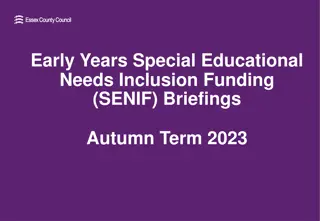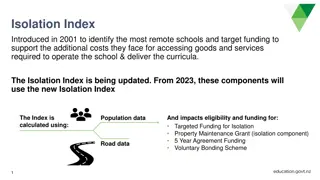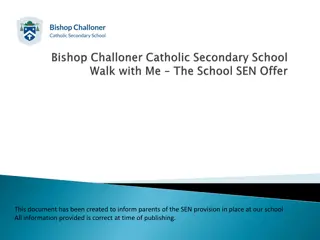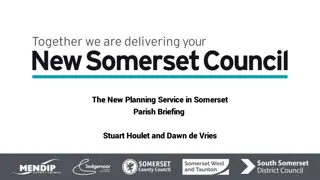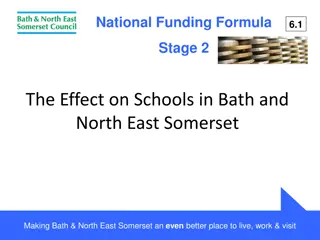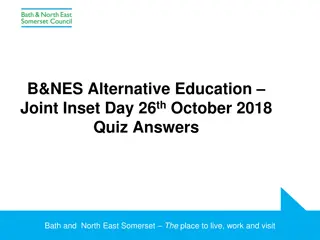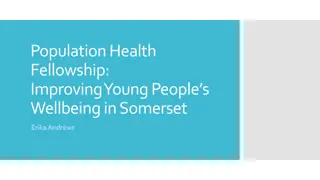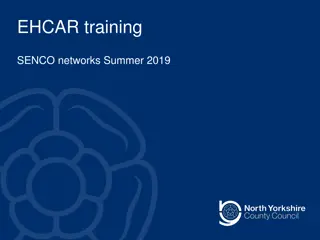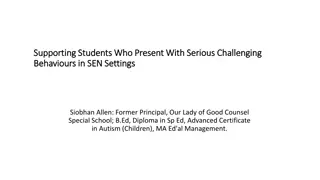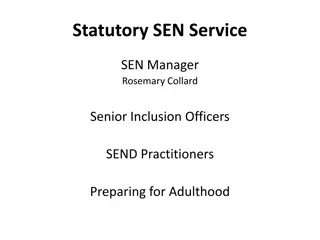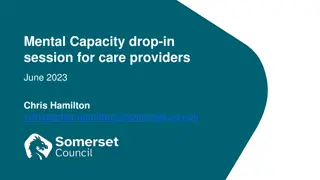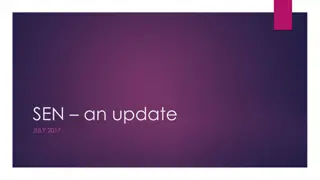Understanding SEN Support and Funding in Somerset Schools
The content delves into the landscape of Special Educational Needs (SEN) in Somerset schools, covering aspects such as the number of children with identified SEN, absence rates, exclusion trends, and government funding allocation. It provides insights into the challenges faced by SEN pupils and the support mechanisms in place to address their needs.
Download Presentation

Please find below an Image/Link to download the presentation.
The content on the website is provided AS IS for your information and personal use only. It may not be sold, licensed, or shared on other websites without obtaining consent from the author. Download presentation by click this link. If you encounter any issues during the download, it is possible that the publisher has removed the file from their server.
E N D
Presentation Transcript
AGENDA FOR TODAY STAGE 1 STAGE 2 STAGE 3 WE WILL PROVIDE SOME BACKGROUND INFORMATION WHICH HAS IMPACTED ON THE PROPOSED CHANGES LOCALLY OPPORTUNITY FOR FEEDBACK AND FURTHER DISCUSSION. DISCUSSION ON CURRENT SITUATION AND PROPOSED CHANGES SENDIAS WILL BE AVAILABLE TO ANSWER QUESTIONS RE SUPPORT.
Ground rules Parents only Mobile phones on low/ silent please Everyone's experience is different. Each one is valid and should be respected. The subject is emotive and its okay if you need to take a break/get upset. No personal attacks please. We are here to present information. Listen to one another and allow everyone who wishes to have a chance to speak.
CHILDREN WITHIN SOMERSET SCHOOLS A few children (2.8%) Mainstream/RB/SC High needs funding & EHCP Targeted (Notional SEN) Some children (11.6%) Mainstream schools Universal (AWPU) All children
WHAT IS THE SEN PICTURE IN SOMERSET 15.6% of children in schools have identified SEND, which equates to 12,000 children and young people (this is in line with regional average) Lower proportion of children with EHCP/Statements than similar areas Absence rates for Somerset s SEN pupils are higher on average than their National peers, and levels of absence are increasing. GCSE results in 2016 for SEN pupils remained below the National average. Fixed term exclusion rates for Somerset s SEN pupils are higher than the National average, and permanent exclusions rates are broadly in line. There has been a significant increase in exclusions (both fixed term and permanent). The largest increase is in secondary schools. SEND children with a need type of Social, Emotional and Mental Health account for the majority of exclusions. The number of young people not in Education, Employment or training (NEET) with SEND in Somerset are in line with latest National data, but levels have increased.
FUNDING FROM CENTRAL GOVERNMENT Funding for schools come directly from central government School block 282.867 and is split into 4 blocks. Early years Early years Preschool aged children Schools block 4-16 Designated schools grant High needs funding Children with special educational needs who require support above provision normally High Needs Funding 49,857 Central Schools services Block found in school Central schools service block This can vary from LA to LA. In Somerset these cover, Somerset Learning Platform, PFSA s, Raising Achievement Plans, part of the Education Welfare service and Ethnic Minority Achievement teams and other support for vulnerable learners rather than SEN children. It also contributes towards 1610 contract, in developing sports and leisure facilities for Somerset children and families.
Why are services being looked at now? School block 282,867m Early years Up until this financial year the council have been able to money between the School block and High needs block with the approval of schools forum. Designated schools grant As from this year, only up to 0.5% can be moved from schools block to High needs without the Secretary of states approval. High Needs Funding 49,857 Central Schools services Block We currently have a deficit of 5.2m in high needs 2016/2017 2.9m over spend 2017/18 2.3m over spend
2014/15 Values 2015/16 Values How do we compare to other areas? Difference between 2014/15 & 2015/16 500 Section 251 Top Up Funding Per Pupil 450 400 350 300 250 200 150 100 50 0 Cornwall Devon Dorset East Sussex Gloucestershire Herefordshire Norfolk Shropshire Somerset Suffolk Wiltshire -50 Statistical Neighbours
FUNDING IMPACT OF NATIONAL FUNDING FORMULA Funds held by school Funds allocated by LA Mainstream Age weighted Pupil Unit 4,000 Delegated up to 6,000 Special Schools and Additionally Resourced Provision (RBs) Top Up Funding Planned place 10,000 per place Independent schools School Fees All Children Children and young people with additional needs Children with Education, Health and Care Plans/top ups
SEN PATHWAY/OFFER FOR PUPILS WITH SEND FUNDING AWPU NOTIONAL SEN. BAND 1------------------------------------BAND 7 SCHOOL FEES MAINSTREAM MAINSTREAM -------------------------------------- RESOURCE BASE ------------------- SPECIAL SCHOOLS ----------- PLACEMENT INDEPENDENT SCHOOLS (GENERAL GUIDANCE ONLY AS INDIVIDUAL DECISIONS WILL BE DEPENDENT ON AGE, TRIBUNALS, CODE OF PRACTICE ETC)
PROPOSED CHANGES TO SUPPORT SERVICE FOR EDUCATION
The journey so far.. The service was reviewed in light of the overspend in the high needs budget. Some areas of SSE were recording an overspend annually and this needed to be looked at. An impact assessment on proposed changes was done. November 17 - Staff within PIMS, Hearing Impairment team and Vision impairment team were informed of the proposed changes in line with HR guidance and legal duties. Some staff posts were put at risk if the proposed changes went ahead. The option for Voluntary Redundancies for all staff within the affected teams were requested by staff during the consultation process. Towards the end of last year meetings with SENCOs took place through the SENCO network and feedback was gained and any concerns from these meetings discussed. All schools were also written to in February informing them of the proposed changes and seeking feedback. Schools were also asked if they had any idea as to how other savings might be made and none have been forthcoming. The la had 3 responses and all of these have had discussion with the Lead SEND school advisor.
How do we compare to other areas? PIMS unlike Hearing and visual support is not classed as a statutory service. Cornwall s service is delivered by Health Dudley s service is around training staff to ensure they understand duties and can implement them. Worcestershire fill this through outreach from special schools Breakdown of spend per child Combined Visual Impairment Hearing Imparement Physical Impairment 0 5 10 15 20 25 Herefordshire Devon Somerset
Who are PIMS working with? Funds allocated by LA Funds held by school Number of pupils Percentage of Caseload 1.3 0.4 1.7 46.8 9.4 6.1 4.6 6.5 8.1 6.9 4.0 2.3 2.1 Mainstream Age weighted Pupil Unit 4,000 Delegated up to 6,000 Can't Find Child on Capita EHE Special School No HN Funding EY Provision MSBM MSB1 MSB2 MSB3 MSB4 MSB5 MSB6 MSB7 TOTAL PIMST CASELOAD 6 2 8 Special Schools and Additionally Resourced Provision (RBs) 224 45 29 22 31 39 33 19 11 10 479 Top Up Funding Planned place 10,000 per place Independent schools School Fees
How resources are used locally Support Services for Education were tasked with looking at best use of resource s. The dive into PIMS data revealed the following. Snap shot of how time has been used taken over one term 26% direct work with child or school 23 23 33% prep work- making resources and photocopying 3 18 18% responding to emails 20 23% not recorded 13 Direct work with Child/YP School meetings Prep work - resources Prep work-other Admin emails Unaccounted for hours
There is a lack of clarity around who should do what Advisory teachers Health services Schools
The Law (EHCP) 9.131 When an EHC plan is maintained for a child or young person the local authority must secure the special educational provision specified in the plan. 9.141 For health care provision specified in the EHC plan, the CCG (or where relevant NHS England) must ensure that it is made available to the child or young person. 3.46 The DMO provides the point of contact for local authorities, schools and colleges seeking health advice on children and young people who may have SEN or disabilities, and provides a contact (or contacts) for CCGs or health providers so that appropriate notification can be given to the local authority of children under compulsory school age who they think may have SEN or disabilities. The DMO can support schools with their duties under the Supporting Pupils with Medical Conditions guidance. The DMO would not routinely be involved in assessments or planning for individuals, except in the course of their usual clinical practice, but would be responsible for ensuring that assessment, planning and health support is carried out. Some CCGs may delegate key decisions to the DMO (for example, agreeing the health services in an EHC plan).
Supporting pupils at school with medical conditions 2014 (SEN SUPPORT) Medical Care Plan- The governing body should ensure that plans are reviewed at least annually or earlier if evidence is presented that the child s needs have changed. They should be developed with the child s best interests in mind and ensure that the school assesses and manages risks to the child s education, health and social well- being and minimises disruption. All schools have duties under the Equality Act 2010 towards individual disabled children and young people. They must make reasonable adjustments, including the provision of auxiliary aids and services for disabled children, to prevent them being put at a substantial disadvantage. These duties are anticipatory they require thought to be given in advance to what disabled children and young people might require and what adjustments might need to be made to prevent that disadvantage. Schools also have wider duties to prevent discrimination, to promote equality of opportunity and to foster good relations.
Back to our journey. The plan was to do engagement events once the staff had been consulted and had an opportunity to respond but due to breaches in confidentiality, information was shared with families before this could happen. This has impacted on staff consultation and families ability to truly help shape what the service could look like moving forward. Why Engagement not consultation? The service is not a statutory service and the impact assessment showed that there would be minimal impact, therefore legally the council did not have to consult. However it is good practice to do this, which is why it is taking place now, after the internal consultation with staff. Scrutiny took place on 16th March and SSE was discussed with 7 families raised questions at scrutiny. These have been responded to in writing.
The story so far.. 479 letters have been sent to families using the service of which 6 have asked for clarification. (4 didn t understand the letter and 2 had concerns) Four engagement events planned over this week and early next week. These are for parent carers only. Parent Carers will also be offered individual meetings with the LA throughout the summer term. Somerset Parent Carer Forum will put a report together based on this information presented today and feedback from the engagement sessions. We have also made some freedom of information requests and are waiting for these. We then have to wait for recommendations from scrutiny on 20th April 2018.
WHAT IS THE FUTURE LIKELY TO LOOK LIKE
PIMS Team Before After 1 manager 8 members of Staff 1 Manager (unknown management time) 3 members of Staff 6.95 Full time people (not inc manager) 2.4 Full time people (not inc manager)
SENATAS Team Before After 1 members of Staff 1 member of Staff 1 Full time people 1 Full time person
Autism and communication Team Before After 9 members of Staff 9 members of Staff 6.8 Full time people 7.30 Full time people
Learning support service Before After 12 members of Staff 11 members of Staff 9.4 Full time people 9 Full time people
Vision Impairment Team Before After 1 manager 9 members of Staff Manager ? 9 members of Staff 4.67 Full time people (not inc manager) 4.74 Full time people (not inc manager)
Hearing Impairment Team Before After 2 managers (1 FTE) 16 members of Staff 2 Managers ? 13 members of Staff 13.22 Full time people (not inc manager) 11.38 Full time people (not inc manager)
EHCPs and care plans Important to ensure that your plans are specific What is the provision When and how much Who by Avoid terms like several, would benefit from, regular. This are difficult to challenge the delivery of. Provision should be linked to a clear outcome. Check you plans and if not specific talk to School and SENDIAS who can advise you of next steps. If it is written in your EHCP the LA have a duty to ensure it is delivered not to deliver it themselves. Lots of support available to help understand rights free of charge
Next Steps Complete engagement events Prepare a report to be presented at scrutiny on 20th April and cabinet 2nd May. Repeated engagement events in 6 months to monitor any impact. Get renewed sign up to the Engagement and Participation Strategy and monitor the impact of this Arrange events on EHCP s. Training for staff- raising awareness of duties of engagement and participation. Recommend individual plans are reviewed and ensure the provision is specific (Emergency annual review called if required)





